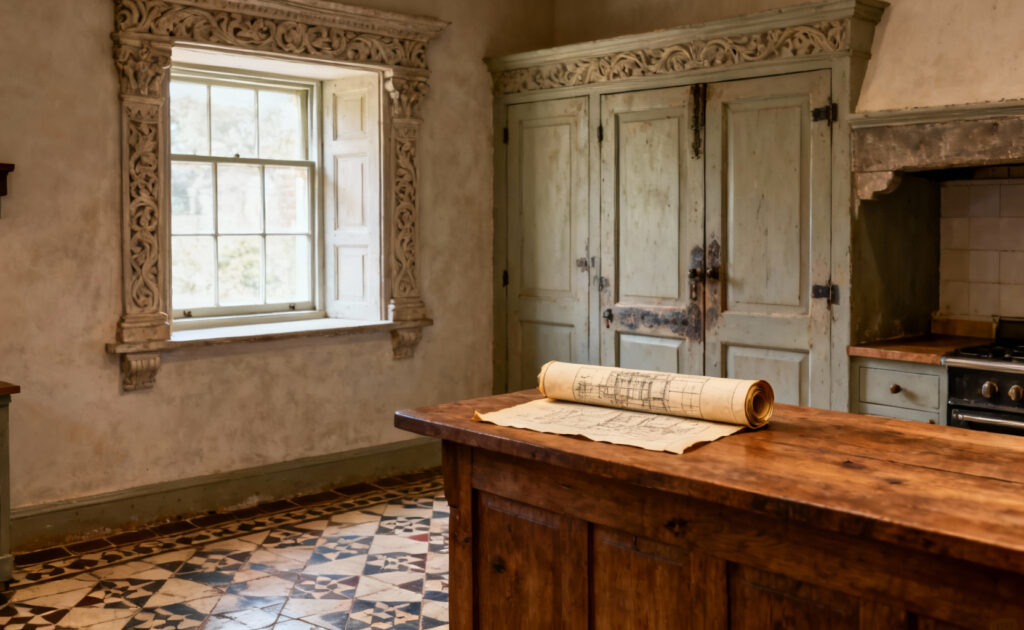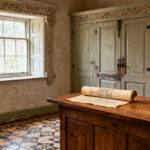Since the earliest days of the hearth, the kitchen has been the undisputed heart of the home. It’s evolved, of course, from a smoky, purely functional workspace tucked away in the back to the bright, social hub it is today. When I work with owners of historic homes, the real challenge, and the real art, is navigating that evolution. Today’s most thoughtful kitchen remodeling ideas for these treasured properties understand this delicate balance—it’s a dialogue between honoring heritage and meeting the very real demands of modern life.
The 20 principles that separate an enduring, soulful renovation from a forgettable, trend-driven update haven’t changed in generations. This isn’t just about picking the right paint color or countertop. It’s about being a good steward of your home’s history. You have to understand its bones, respect its story, and then, very carefully, weave in the functionality you need. It requires a deep appreciation for craftsmanship and an honest approach to the complexities of these projects. So let’s walk through it together. We’ll start with the philosophical foundation, move to the materials that give it texture, then talk about arranging the space, and finally, how to truly integrate it into your life.
Philosophical Anchor: Laying the Foundation for Enduring Design (Part 1)
Before a single floorboard is pulled up, the real work begins. It’s a quiet, thoughtful process of understanding what your house is and what it wants to be. Rushing this stage is the single biggest mistake you can make. This is about establishing a core philosophy that will guide every decision, ensuring your kitchen remodel feels less like an imposition and more like a homecoming.
1. Read Your Home’s Architectural Story
First things first: you have to learn to read your house. Every old home has a story, a distinct architectural language spoken through its trim, its windows, the height of its ceilings, even the way its rooms connect. To ignore this and simply paste in a design you saw online is to create a space that will always feel slightly…off. Whether you live in a stately Victorian, a humble Arts and Crafts bungalow, or a graceful Colonial Revival, each style has its own logic and material honesty.
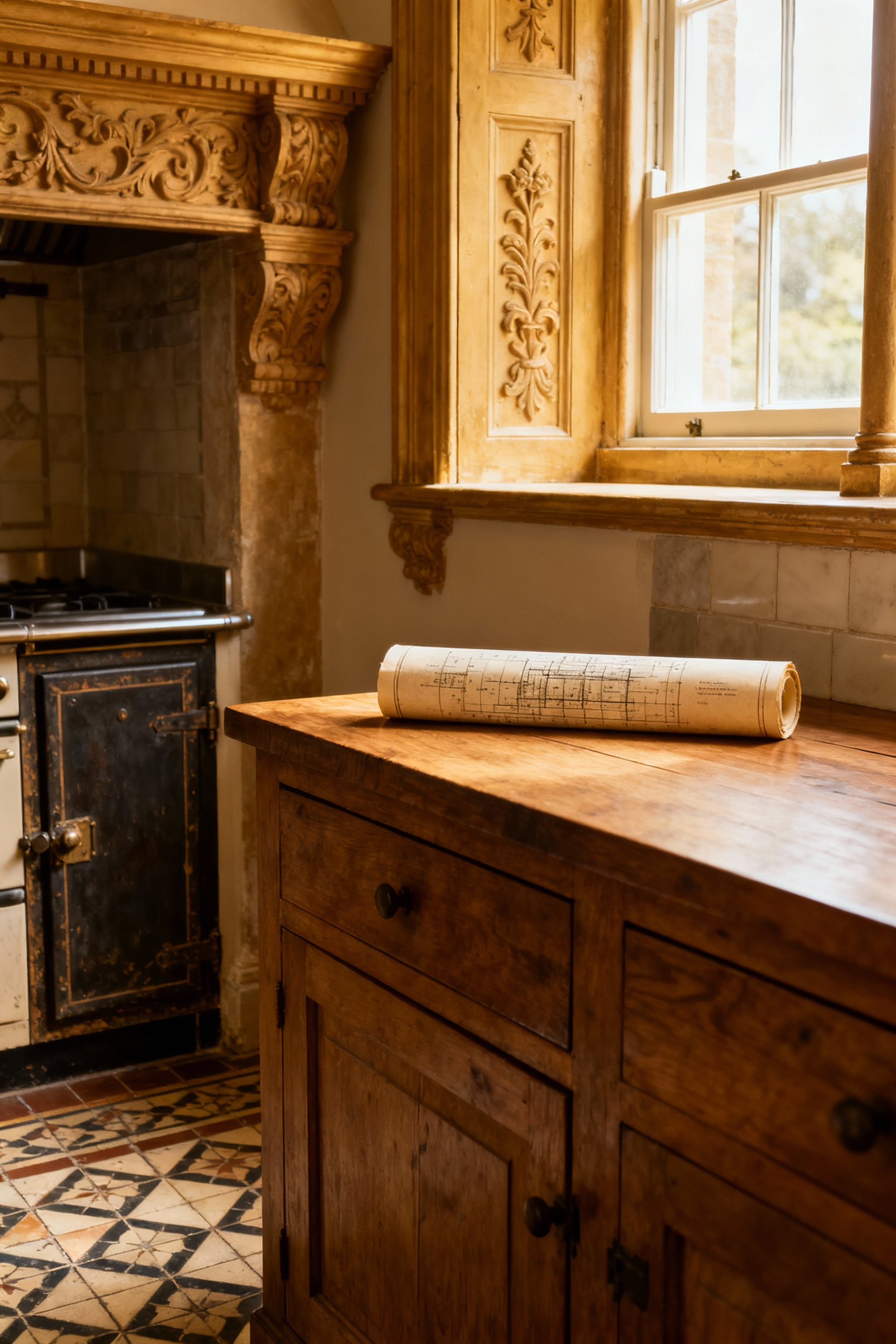
Take the time to study these details. A massive, open-plan kitchen might feel utterly wrong in a 19th-century home built around a series of smaller, purposeful rooms. But you can still create flow by widening a doorway or creating a cased opening that respects the home’s original sense of proportion. What I tell my clients and readers is this: Your house gives you the design brief. A Craftsman home asks for the honesty of unpainted wood and hammered metal; a Federal home calls for refined, painted cabinets and delicate details. This isn’t about creating a museum. It’s about making your new kitchen speak the same language as the rest of your home, ensuring it feels like an organic and brilliant extension of the original story.
2. Weave in Modern Performance Discreetly
Once you understand the story, the next challenge is integrating the machines of modern life without ruining the plot. Frankly, your 1910 kitchen wasn’t designed for a French-door refrigerator, a whisper-quiet dishwasher, or proper ventilation. The trick is a kind of sophisticated sleight-of-hand. The goal is to make the 21st century disappear.
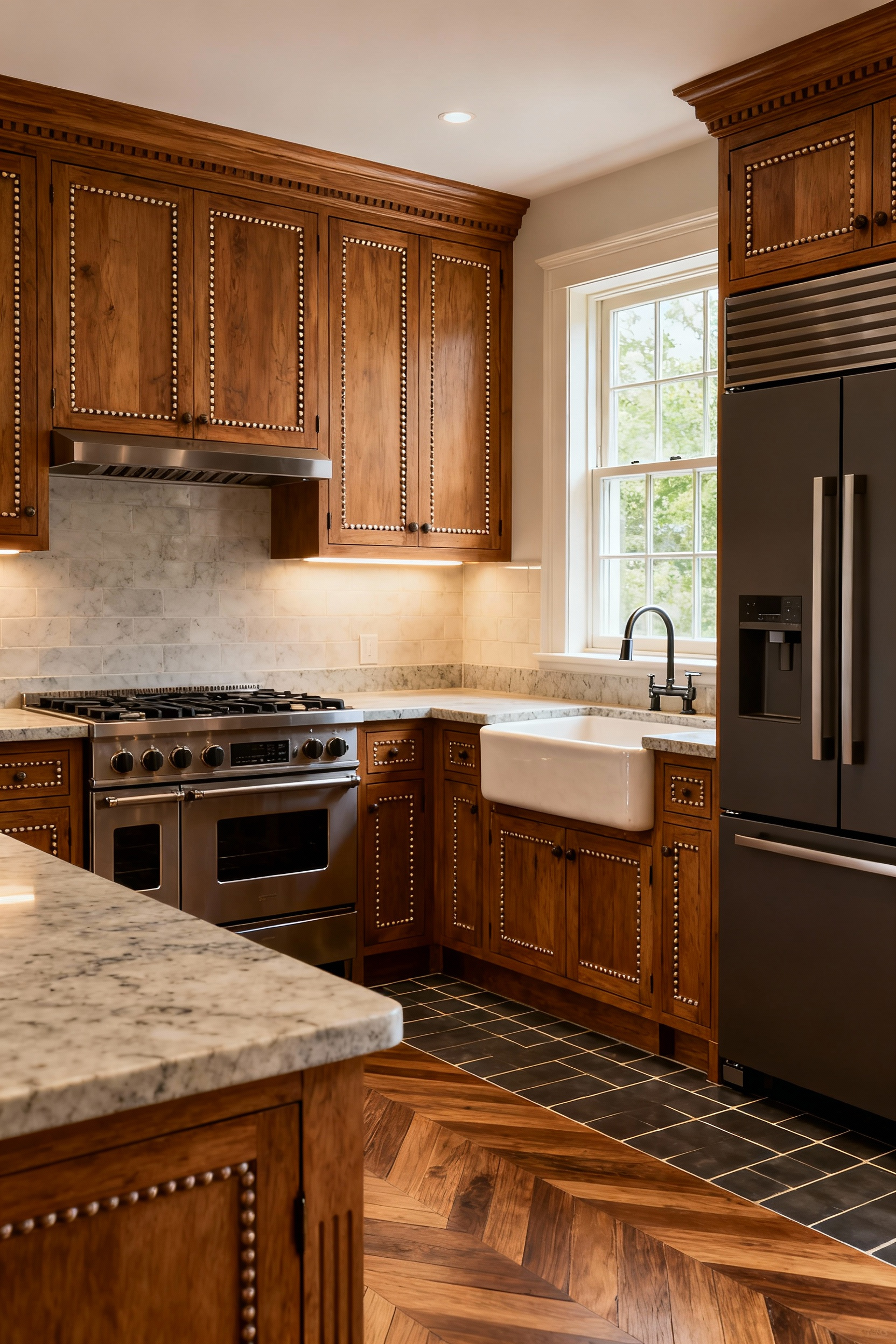
This is where panel-ready appliances are your best friend. A high-performance refrigerator or dishwasher can vanish completely behind custom cabinet fronts built to match the period style. For cooktops, a sleek induction surface can sit nearly flush with a beautiful stone counter, and the powerful ventilation it requires can be hidden inside a custom hood designed to look like a traditional mantelpiece or hearth surround. In my historic home renovation specialist practice, the moment a client sees how a paneled appliance seamlessly integrates is often a turning point. They realize they don’t have to choose between historical authenticity and modern performance. They can, in fact, have both, engineering a kitchen that works incredibly hard but looks as if it’s barely working at all.
3. Embrace Sustainable Preservation
The most sustainable building is the one that’s already standing. The ethos of preservation is inherently green, and your kitchen remodel should reflect that. It starts with a simple mantra that I believe is the cornerstone of responsible renovation: repair, don’t replace. That slightly imperfect set of original cabinets might be made from old-growth wood that’s denser and more durable than anything you could buy today. Refinishing, reconfiguring, or even just updating the hardware can bring them beautifully into the present while keeping a priceless piece of your home’s history out of a landfill.
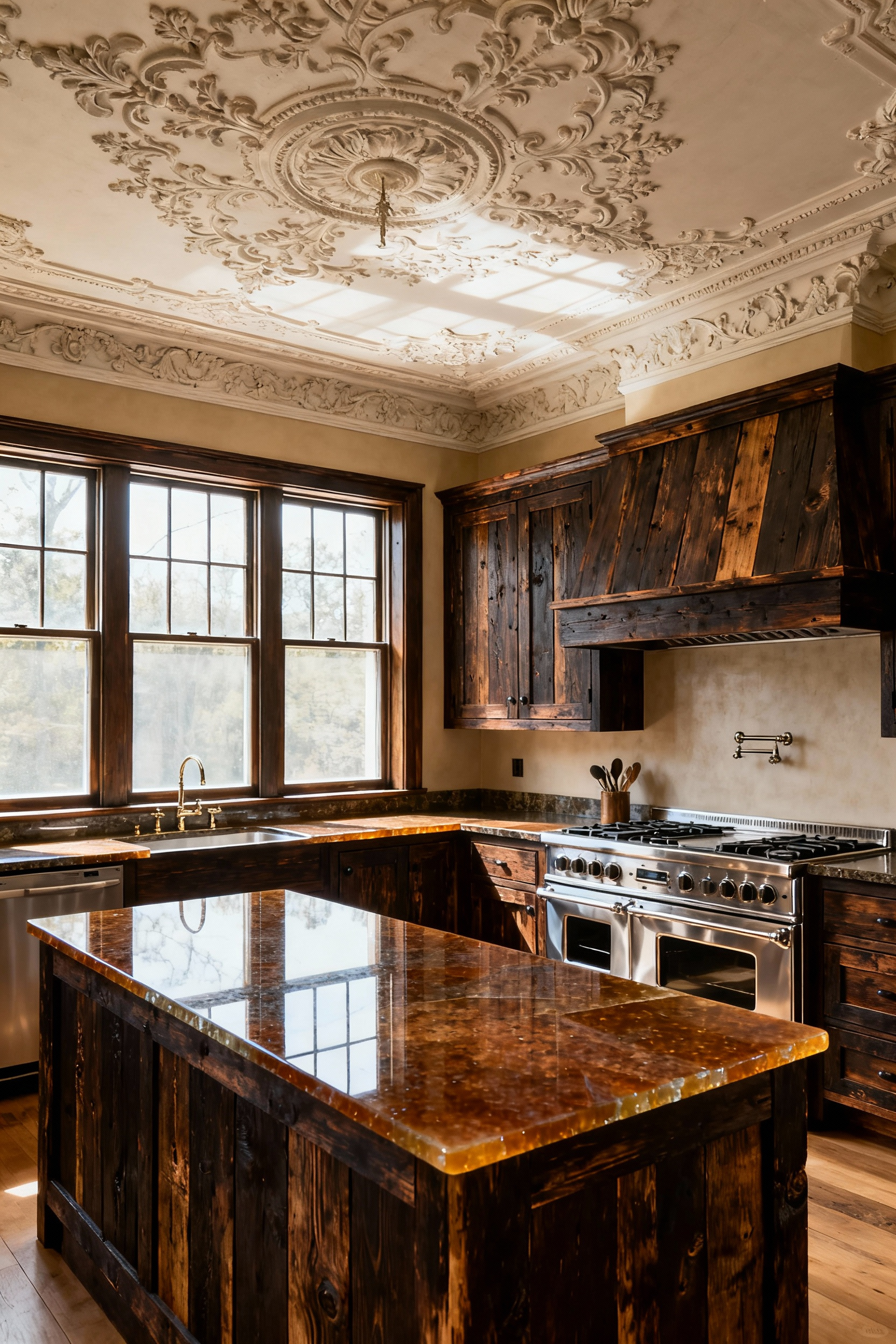
When you do need new materials, think reclaimed. Sourcing old floorboards, ceiling beams, or even salvaged brick adds a layer of character that new materials simply can’t mimic. And it’s not just about aesthetics. Upgrading insulation where possible, specifying ENERGY STAR appliances, and using quality, low-VOC paints are all part of a holistic approach. From my work in Period-Appropriate Renovation, I can tell you that this isn’t just about being environmentally correct; it’s about honoring the original builders’ intent. They built things to last for generations, and by preserving and reusing, you’re participating in that legacy of longevity.
4. Become an Architectural Detective
Building on that respect for the original, the most rewarding projects I’ve been a part of have involved a bit of detective work. Researching your home’s provenance—its history—isn’t just for academic purposes; it’s a wellspring of design inspiration that ensures your choices are deeply informed and authentic. A trip to the local historical society, a search for old photographs or blueprints, or even carefully peeling back layers of paint can reveal so much.

Did your kitchen originally have a particular style of beadboard? A specific color on the walls? A built-in pantry that was later removed? You might uncover a “ghost” of an old doorway or find that the floor was originally simple, wide-plank pine. I learned this when we did a paint analysis on a c. 1890 kitchen and found a sliver of the original deep blue-green paint on a piece of hidden trim. We used that as our primary cabinet color, and it grounded the entire project in its own history. This research doesn’t force you into a strict replica, but it provides a beautiful, historically accurate palette to draw from, making your remodel a true continuation of your home’s narrative.
Philosophical Anchor: Laying the Foundation for Enduring Design (Part 2)
Before we start choosing materials, there’s one more foundational piece to discuss. This isn’t about aesthetics; it’s about the practical realities and rules that govern work on historic properties. Understanding this landscape from the start saves headaches and ensures your project respects not just the spirit of the house, but the letter of the law.
5. Navigate a Partnership with Preservation Regulations
If your home is in a historic district or is individually landmarked, you’ll be working with a local Historic Preservation Commission. Many homeowners hear this and immediately see roadblocks and red tape. I want you to reframe that. These guidelines are there to protect the character of the place you fell in love with. The key is to approach the commission not as an adversary, but as a resource and a partner.
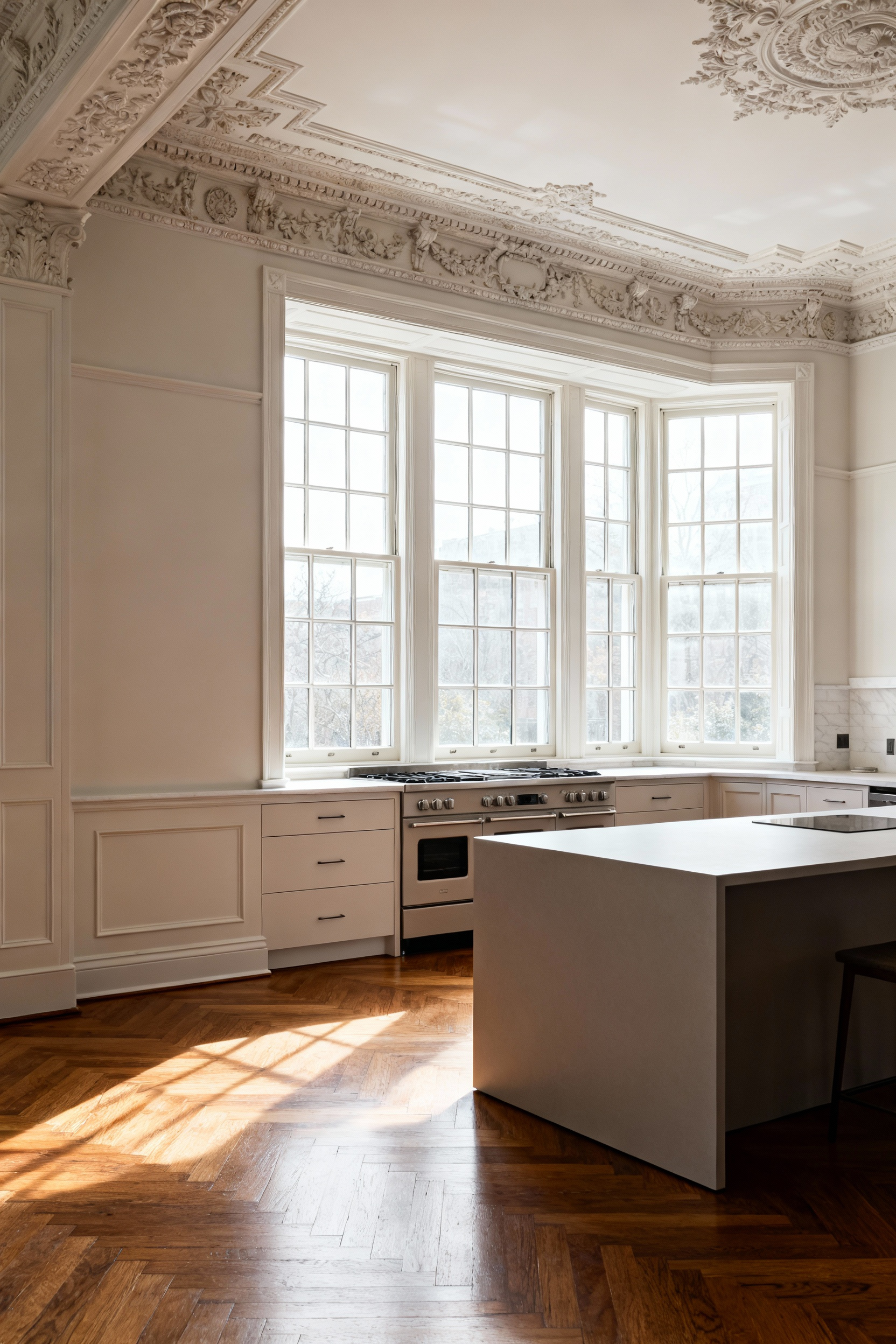
Engage them early. Before you’ve spent a dime on design, have a conversation. Understand the standards—usually based on the Secretary of the Interior’s Standards—and what they mean for your property. They may have significant input on exterior changes, like windows or additions, but offer more flexibility for interiors that have already been altered. A skilled architect with historic preservation experience is invaluable here; they speak the language and can help you craft a proposal that achieves your goals while respecting the guidelines. In my professional experience, commissions respond best to homeowners who have clearly done their homework and demonstrate a genuine respect for their home’s heritage. When you present thoughtful solutions that blend preservation with innovation, you’re not just seeking approval; you’re showing you’re a worthy steward of an important piece of architectural history.
Material Exploration: Crafting Authenticity Through Tactile Elements (Part 1)
With our philosophy firmly in place, we can now turn to the most tangible part of the design: the materials. This is where the character of a historic kitchen is either honored or lost. Every surface, every finish, every piece of hardware is a choice that will either add to the home’s story or detract from it. It’s about creating a room that feels as good as it looks.
6. Source Timber with a Story: Reclaimed and Period-Appropriate Wood
In an old home, wood is king. The choice of timber for your cabinets, floors, or ceiling beams is one of the most critical decisions you’ll make. It’s a chance to infuse the space with an immediate sense of history and warmth. Sourcing reclaimed wood—from old barns, factories, or other demolished structures—is my preferred route. This wood often comes from old-growth forests and has a density, stability, and richness of color that new lumber simply can’t match.
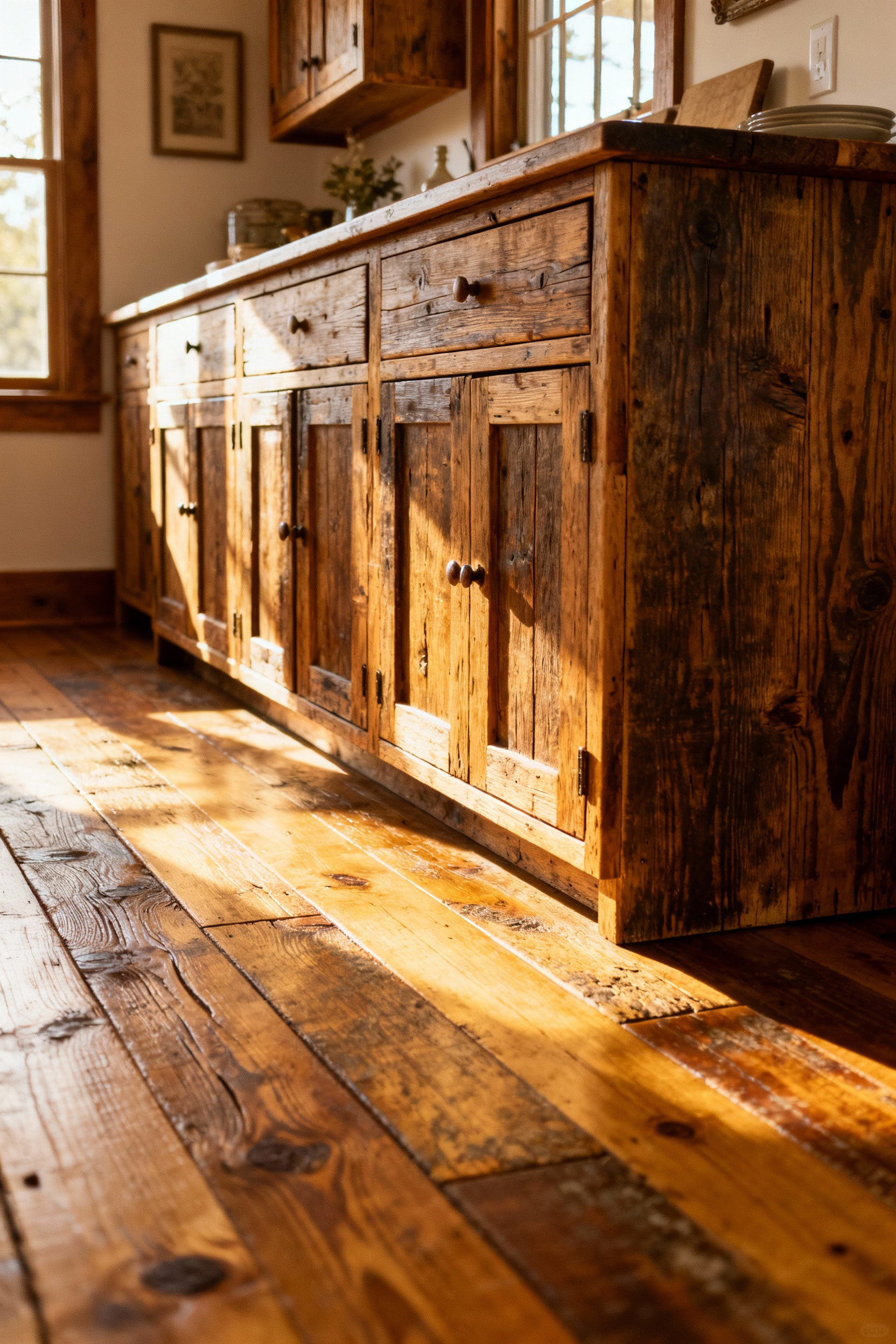
When reclaimed isn’t an option, choose a species that’s appropriate for your home’s era, like quarter-sawn oak for a Craftsman house or heart pine for a colonial-era property. The key is craftsmanship. Ensure the wood is shaped with traditional joinery—dovetails, mortise and tenons—and finished by hand. I’ve noticed a trend for “distressed” new wood, but there is no substitute for the authentic patina of truly old timber. The nail holes, saw marks, and subtle undulations tell a real story, adding a layer of soul to your kitchen that you just can’t fake.
7. Curate Countertops That Age Gracefully
Your countertops are the primary work surface of your kitchen, and they need to be tough. But in a historic setting, they also need to have character. This is one area where I encourage clients to embrace materials that show their age. A perfectly sterile, uniform surface can look stark and out of place. Natural stones are often the best choice because they develop a patina over time—a visual record of the life lived around them.
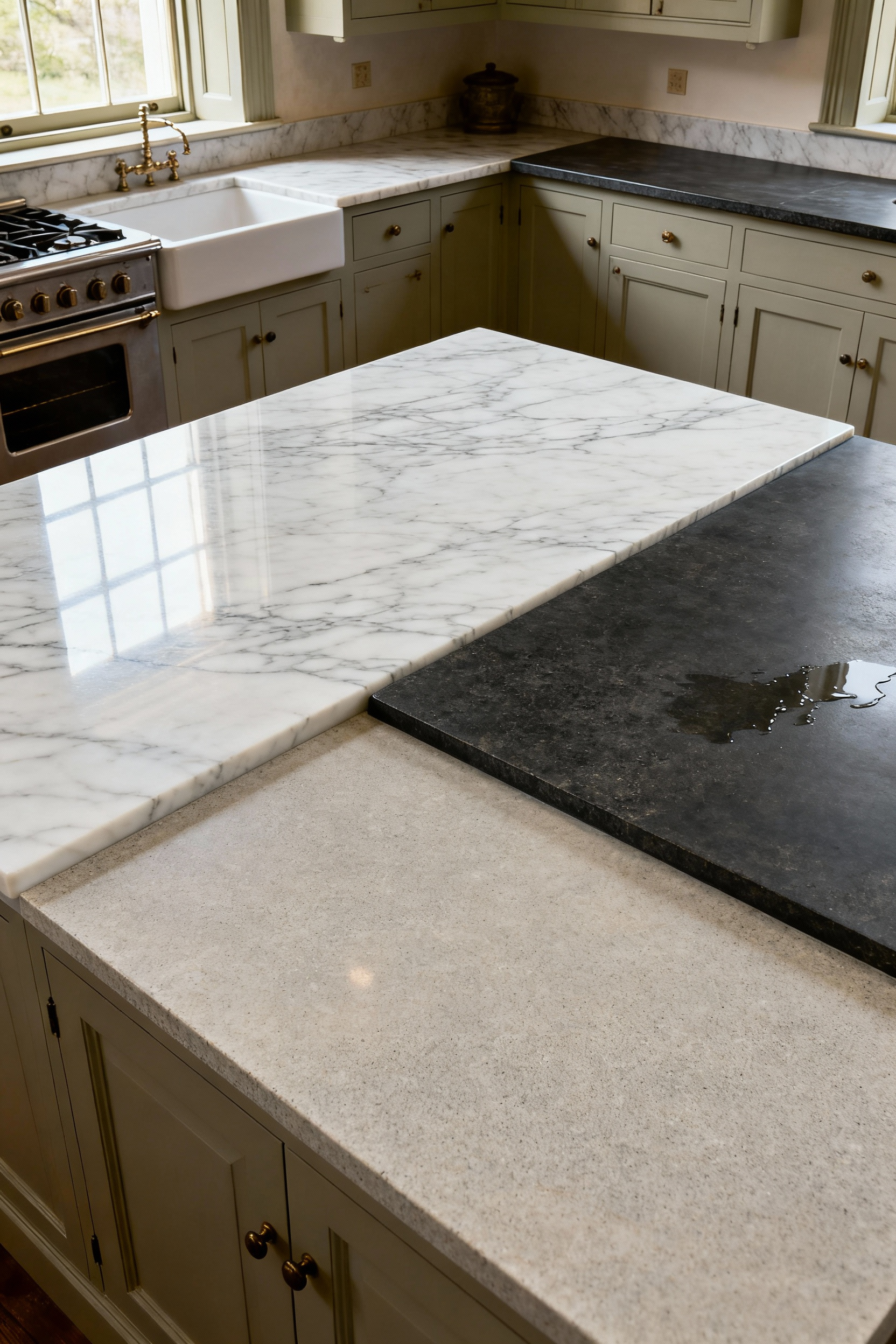
Veined marble is classic for a reason; its luminous quality is unmatched. Yes, it will etch and show wear. But to many of us who love old houses, that’s not a flaw, it’s a feature. Honed soapstone is another favorite. It’s wonderfully heat-resistant, has a deep, velvety color, and can be easily sanded and re-oiled to remove any scratches. For a more humble aesthetic, a thick butcher block on an island can add incredible warmth. The point is to choose a material that evolves with you. I always say a little etching on a marble counter is like a laugh line on a face—it’s a sign of a happy, well-used life, not something to be erased.
8. Select Hardware That Feels Right in Your Hand
Architectural hardware—the knobs, pulls, and latches on your cabinets—is the jewelry of the kitchen. It’s a small detail that has an enormous impact on the authenticity and feel of the space. It’s also one of the easiest places to get it wrong. The historical period of your home should guide the style, but the material is just as important.

I almost always specify unlacquered brass. It’s a “living finish,” meaning it will tarnish and darken over time, developing a beautiful, complex patina that plastic-coated modern brass never will. Forged iron, polished nickel, and oil-rubbed bronze are also excellent choices depending on the home’s style. And don’t underestimate the power of salvage. A set of original cabinet latches can bring an irreplaceable sense of history to new cabinetry. I learned this when a client spent a fortune on stunning custom cabinets but tried to save money on cheap, lightweight hardware. It cheapened the whole effect. The weight and solid feel of well-made hardware is a tactile reminder of quality every single time you open a door.
9. Use Artisanal Tile to Add Texture and Pattern
Tile offers a fantastic opportunity to layer in color, pattern, and texture that feels deeply connected to historical craft traditions. Forget perfectly uniform, mass-produced tiles. The beauty often lies in the imperfection. Think of Moroccan zellige tiles, with their subtle variations in color and hand-cut edges that create an iridescent, light-reflecting surface. Or consider encaustic cement tiles, whose bold, inlaid patterns were hugely popular in the Victorian era and can create a stunning focal point on a floor or backsplash.
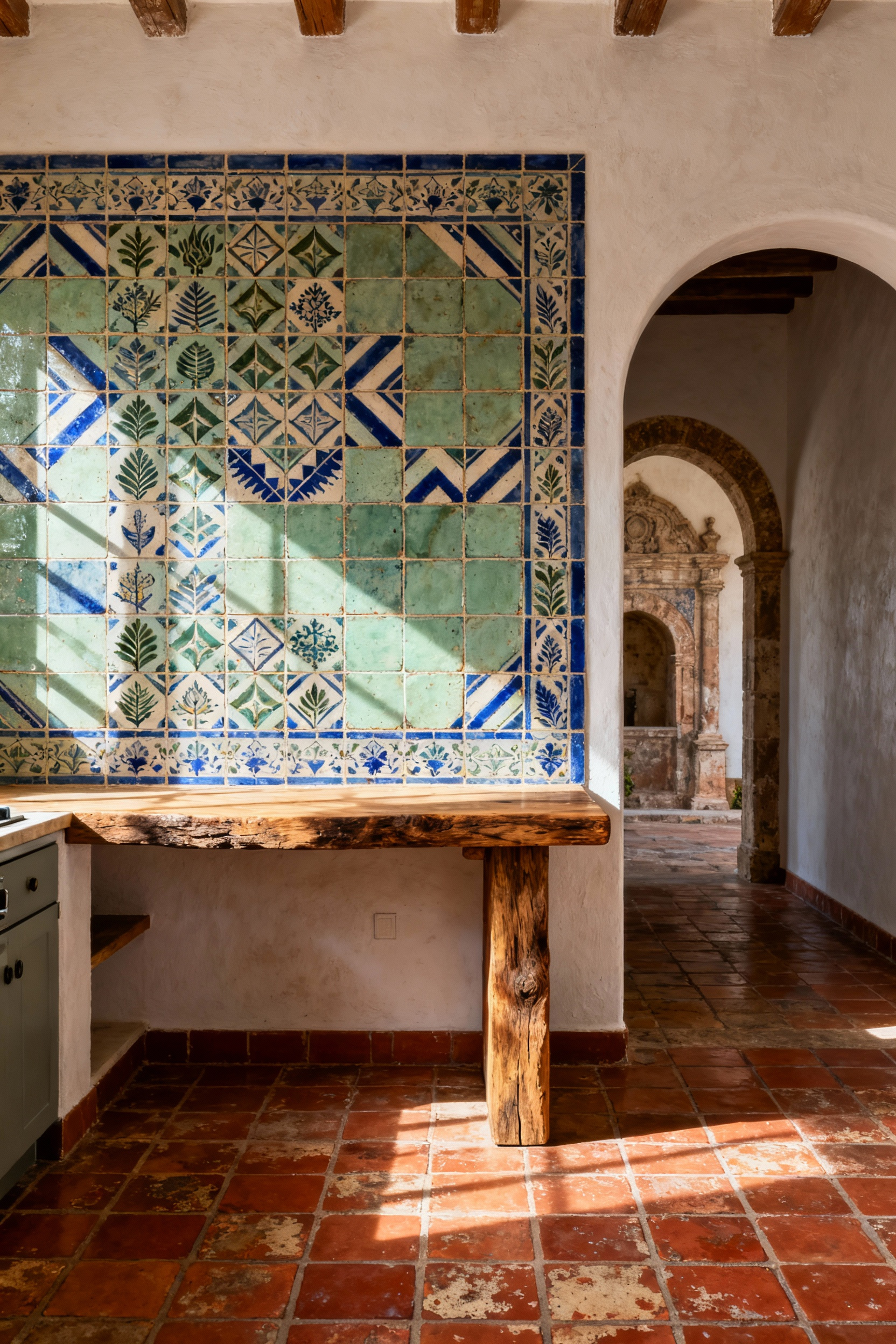
Even a simple subway tile can feel historically appropriate if it has a slightly irregular surface and you use a grout line consistent with the period. The goal is to choose a tile that feels like it was made by human hands. In my professional experience, perfectly flat and uniform surfaces can feel sterile in a house that was built before the machine age. A little bit of texture and irregularity in the tile helps it sit more comfortably within the home’s original handcrafted fabric.
Material Exploration: Crafting Authenticity Through Tactile Elements (Part 2)
We’ve covered the solid materials, but now let’s discuss one that is ephemeral yet just as critical: light. How natural light enters and moves through your kitchen has a profound effect on the feel of the space and how the other materials are perceived. It’s an essential, dynamic ingredient in any successful historic kitchen design.
10. Harness Natural Light with Historically Sympathetic Windows
Natural light is a powerful design tool. In a historic kitchen, the goal is to maximize it without compromising the architectural integrity of your home, specifically its fenestration—the arrangement of its windows. The best approach starts with preservation. If you have original wood windows, restore them. Don’t replace them. The wavy, imperfect quality of old glass and the delicate profile of original muntins (the slender strips of wood that divide the panes) are details that give a historic home its soul.

If replacement is unavoidable, invest in high-quality, architecturally accurate reproductions that match the originals in every detail, from the material to the sightlines. Beyond the windows themselves, you can use light as a material. A transom window above a doorway can pull light deeper into the home. Lightly colored paint finishes, a reflective backsplash tile, or even a polished nickel faucet can help bounce light around the room, making it feel brighter and more open. What I tell my clients is that the way light filters through an original, wavy-glass sash window is fundamentally different and gentler than the light through a perfectly flat, modern pane. Preserving that quality of light is preserving a piece of the home’s atmosphere.
Spatial Application: Sculpting Functionality Within Architectural Constraints (Part 1)
With our design philosophy and materials in place, we arrive at the biggest puzzle: the layout. Historic kitchens were rarely designed for the way we live and cook today. They were often small, isolated, and inefficient. The challenge is to carve out a highly functional, modern workspace within the unyielding architectural constraints of an old house.
11. Adapt the Work Triangle to Your Home’s Real Footprint
The classic ergonomic work triangle—the efficient path between the fridge, sink, and cooktop—is a sound principle, but you can drive yourself mad trying to impose a perfect triangle onto the quirky footprint of a historic kitchen. You’re dealing with thick plaster walls you can’t easily move, old chimneys, and multiple doorways. You have to adapt.

Instead of a rigid triangle, I encourage thinking in terms of “work zones.” You might have a clean-up zone with the sink and dishwasher, a prep zone on an island or a long stretch of counter, and a cooking zone with the range and wall ovens. The goal is the same—to minimize steps and create a logical flow—but the geometry is more flexible. In a long, narrow galley kitchen common in townhouses, this might be a linear, two-wall layout. The beauty of working within these constraints is that it often forces more creative—and ultimately more interesting—solutions than a blank slate ever could. You’re not just designing a kitchen; you’re solving a unique historical puzzle.
12. Integrate Appliances without Disrupting the Visual Flow
We touched on this earlier, but it bears repeating in the context of layout. Placing modern, professional-grade appliances requires a delicate touch to avoid a jarring contrast with the home’s period charm. Their sheer bulk and typically stainless-steel finish can easily overwhelm a historic space. Integrating them discreetly is one of the most important aspects of your spatial planning.
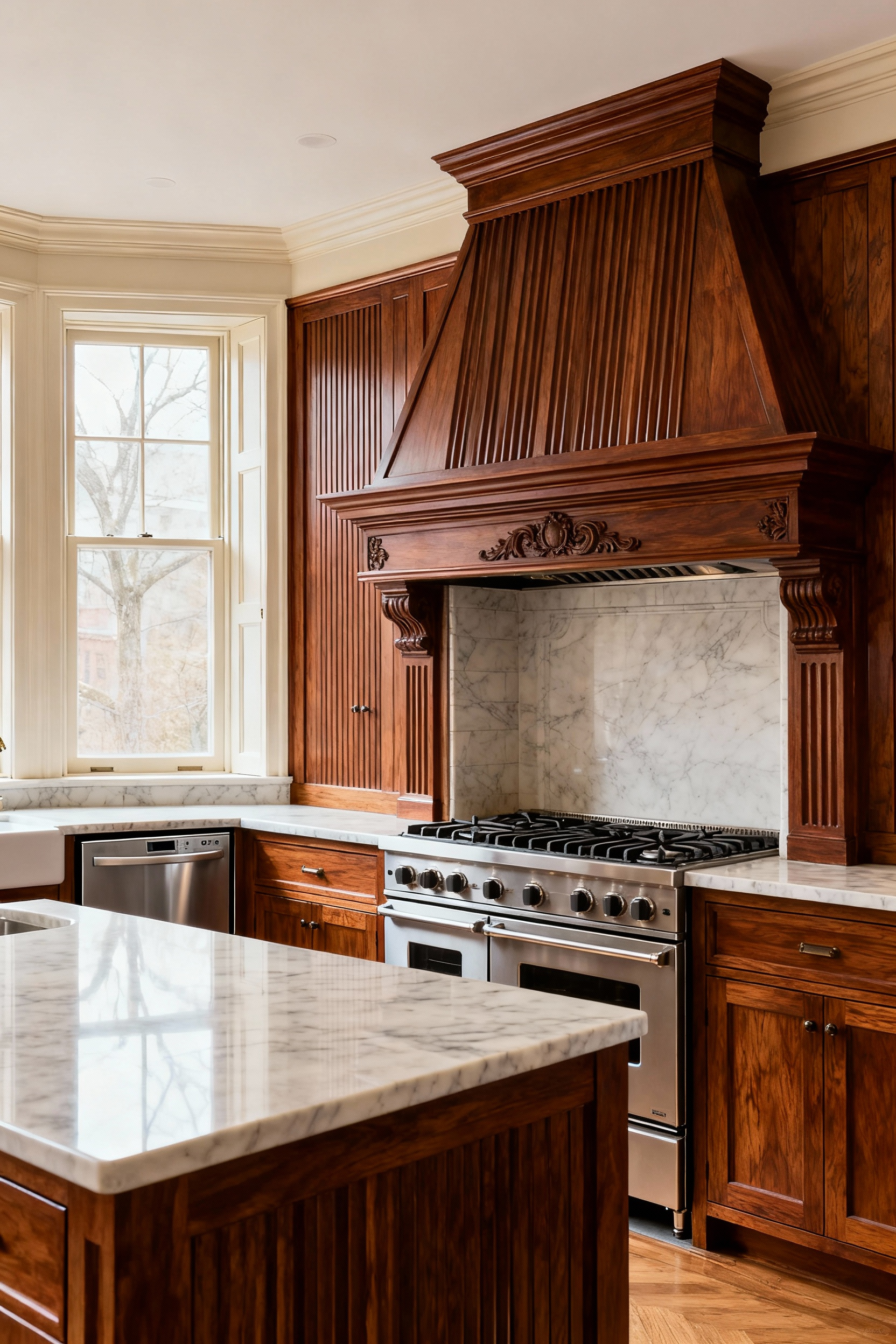
Panel-ready is the gold standard for refrigerators and dishwashers, making them disappear into the cabinetry. But for ranges and wall ovens, you need other strategies. You can recess a large range into an alcove, framed to look like an original hearth. Wall ovens can be housed in a full-height bank of cabinetry designed to resemble an antique freestanding piece like a Welsh dresser or armoire. I’ve seen this work best when we tuck secondary appliances, like a microwave drawer or wine fridge, into a less prominent spot like a butler’s pantry or the back of a kitchen island, keeping the main sightlines clear and historically focused.
13. Design Bespoke Storage That Speaks the Right Language
Storage is probably the number one complaint about historic kitchens. They simply weren’t built with it in mind. The solution is custom, built-in cabinetry that maximizes every square inch while speaking the same architectural language as the rest of your home. This means meticulously matching the profiles of the doors, the style of the trim, and the character of the hardware to what’s already there.
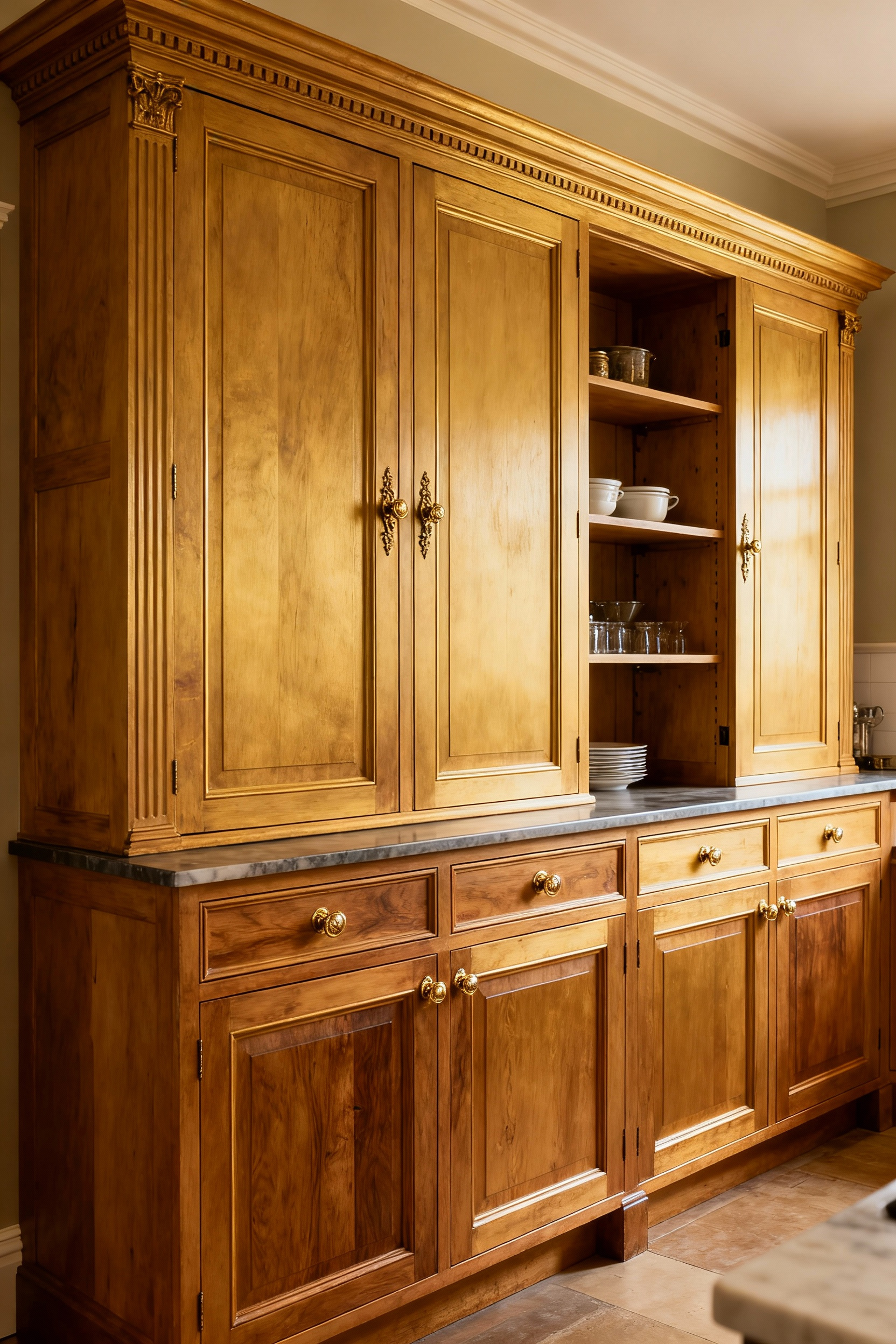
The magic happens when you conceal modern storage solutions behind this traditional facade. Think full-extension drawers, pull-out pantry shelves, and clever corner cabinet systems, all hidden behind beautiful, period-appropriate inset cabinet doors. Look for opportunities to turn architectural quirks into storage assets: an unused alcove can become a display niche for cookbooks, or a shallow space between wall studs can become a recessed spice rack. I’ve noticed clients are consistently amazed by how much functional storage we can create. A well-designed kitchen in a historic home shouldn’t feel compromised; it should feel cleverly and elegantly efficient.
14. Optimize the Paths and Passages
Think about how you move not just within the kitchen, but through it. In many old homes, the kitchen is a thoroughfare to other parts of the house—a back door, a dining room, a staircase. A successful remodel has to accommodate this circulation without letting it interfere with the cooking workflow. It’s about creating clear, unobstructed paths.

This might mean something as simple as moving a doorway a few feet to direct traffic away from the main work zone. Or perhaps replacing a swinging door with a pocket door that disappears into the wall, freeing up precious floor space and creating a more open feel. You have to consider the thresholds, too. How does the kitchen floor transition to the dining room floor? A smooth, seamless transition is always preferable to an awkward change in level. The goal is an effortless flow. You want the kitchen to feel like a natural and gracious hub, not a cluttered obstacle course.
Spatial Application: Sculpting Functionality Within Architectural Constraints (Part 2)
We’ve arranged the interior, but the work isn’t done. A truly successful historic kitchen remodel understands that the kitchen doesn’t exist in a vacuum. It has to connect, visually and functionally, to the rooms around it, creating a cohesive experience that makes the whole house feel more complete.
15. Create a Symbiotic Connection to Adjacent Rooms
The art of a great renovation is ensuring the new kitchen feels like it’s in a conversation with its neighbors—the dining room, the family room, the hallway. It shouldn’t feel like a completely different world teleported into your old house. This requires a symbiotic design strategy, one that fosters a graceful, organic connection.

Start by carrying architectural details across the threshold. The same crown molding or baseboard profile from the dining room should continue into the kitchen. The style of the casings around the doorways should match. You can also create continuity through color and material. Pull a secondary color from an adjacent room’s wallpaper to use on your cabinets. Let the finish of the wood floors flow seamlessly from one space to the next. My personal insight here is that when this is done right, you shouldn’t be able to tell where the “old” house ends and the “new” kitchen begins. It should all feel like one unified, thoughtful design.
Lifestyle Integration: Sustaining Legacy and Modern Livability (Part 1)
Now that we’ve designed the space, let’s talk about living in it. A modern kitchen is so much more than a place to cook. It’s a homework station, a coffee bar, a place to entertain, a hub for family life. The final layer of design is integrating these multi-faceted lifestyle needs into your historic kitchen in a way that feels both natural and supportive.
16. Cultivate Multi-Functional Zones for Modern Life
To accommodate the many hats a modern kitchen wears, you need to think in terms of multi-functional zones. This isn’t about creating a vast, undefined space; it’s about designing distinct areas that can adapt to different activities, all within your kitchen’s historic fabric. An island is the perfect example of this. One end might be dedicated to prep work, with a second sink and butcher block counter. The other end, with comfortable seating, becomes the spot for breakfast, homework, or chatting with the cook.

Think about integrating a small desk area into a run of cabinetry, creating a dedicated spot for managing the household that can be closed up when not in use. A banquette built into a sunny corner creates a cozy spot for casual meals that feels more intimate than a formal dining table. It’s about making the space flexible. Your kitchen needs to be able to host a holiday party on Saturday night and a quiet morning with coffee and the newspaper on Sunday. Smart zoning makes that possible.
17. Plan for Technology That Stays Out of Sight
Intelligent technology can make life in the kitchen infinitely easier, but it can also clutter your counters and clash with a historic aesthetic. The key is to plan for it from the beginning, integrating it in a way that is discreet and anticipates future needs. It’s less about the gadgets themselves and more about the infrastructure.
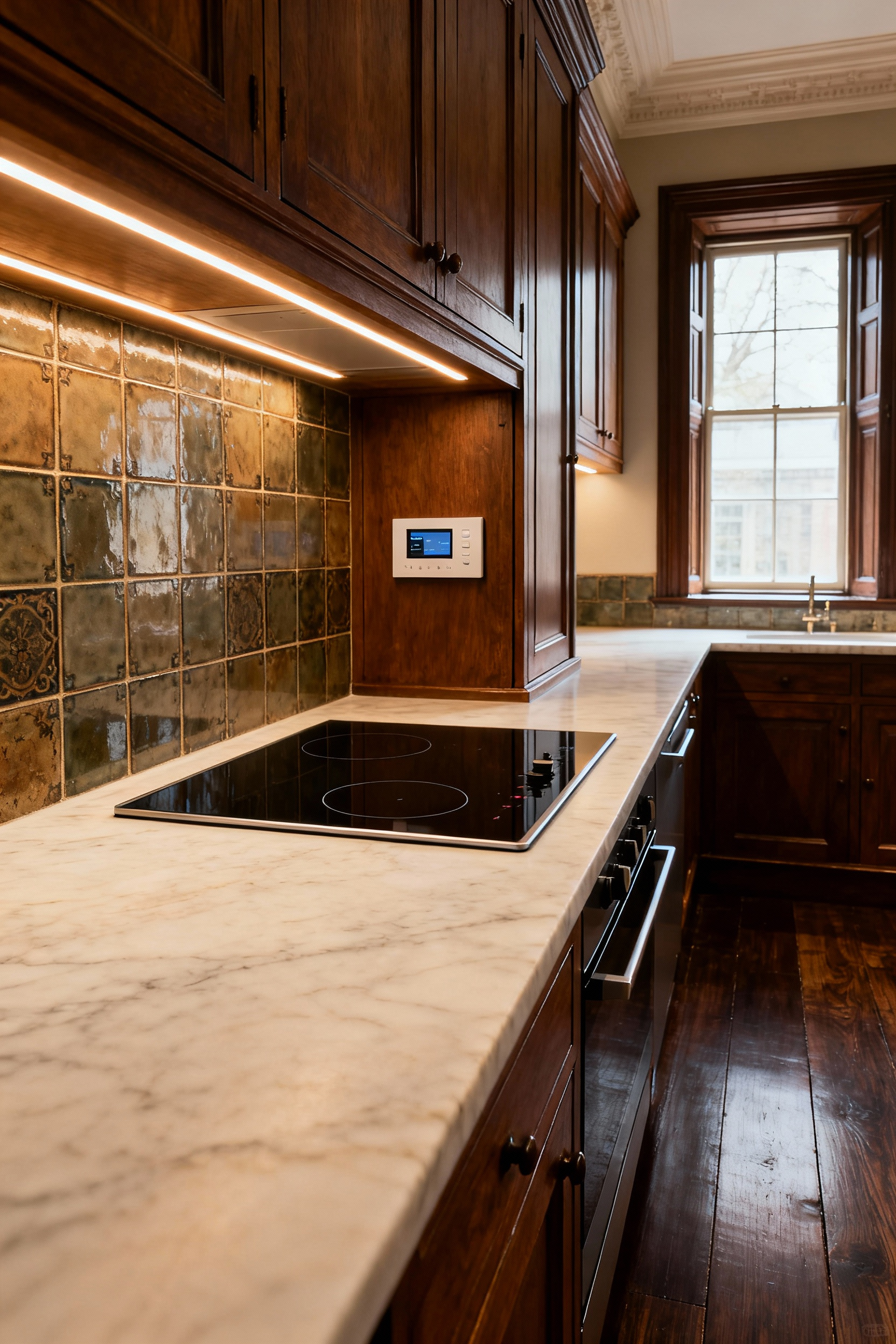
During the renovation, run conduit for everything—data, speakers, smart controls. It’s far cheaper to do it when the walls are open. Design a dedicated “charging drawer” with built-in outlets to keep phones and tablets off the countertops. Think about where you want smart speakers or a small screen and plan for hidden power and mounting. The biggest regret I hear from clients five years after a renovation is that they didn’t plan for enough tech infrastructure. The technology will change, but having the wiring in place makes future upgrades easy and keeps your historic kitchen from being overrun with a tangle of modern cords.
18. Establish a Maintenance Plan to Protect Your Investment
A kitchen remodel in a historic home is a significant investment of time, money, and care. To protect that investment, you need a proactive maintenance plan from day one. This isn’t exciting, but it’s essential for the long-term stewardship of your home. It starts with understanding the materials you’ve chosen. How do you properly care for the soapstone counters? What’s the right way to clean the unlacquered brass hardware to maintain its patina?
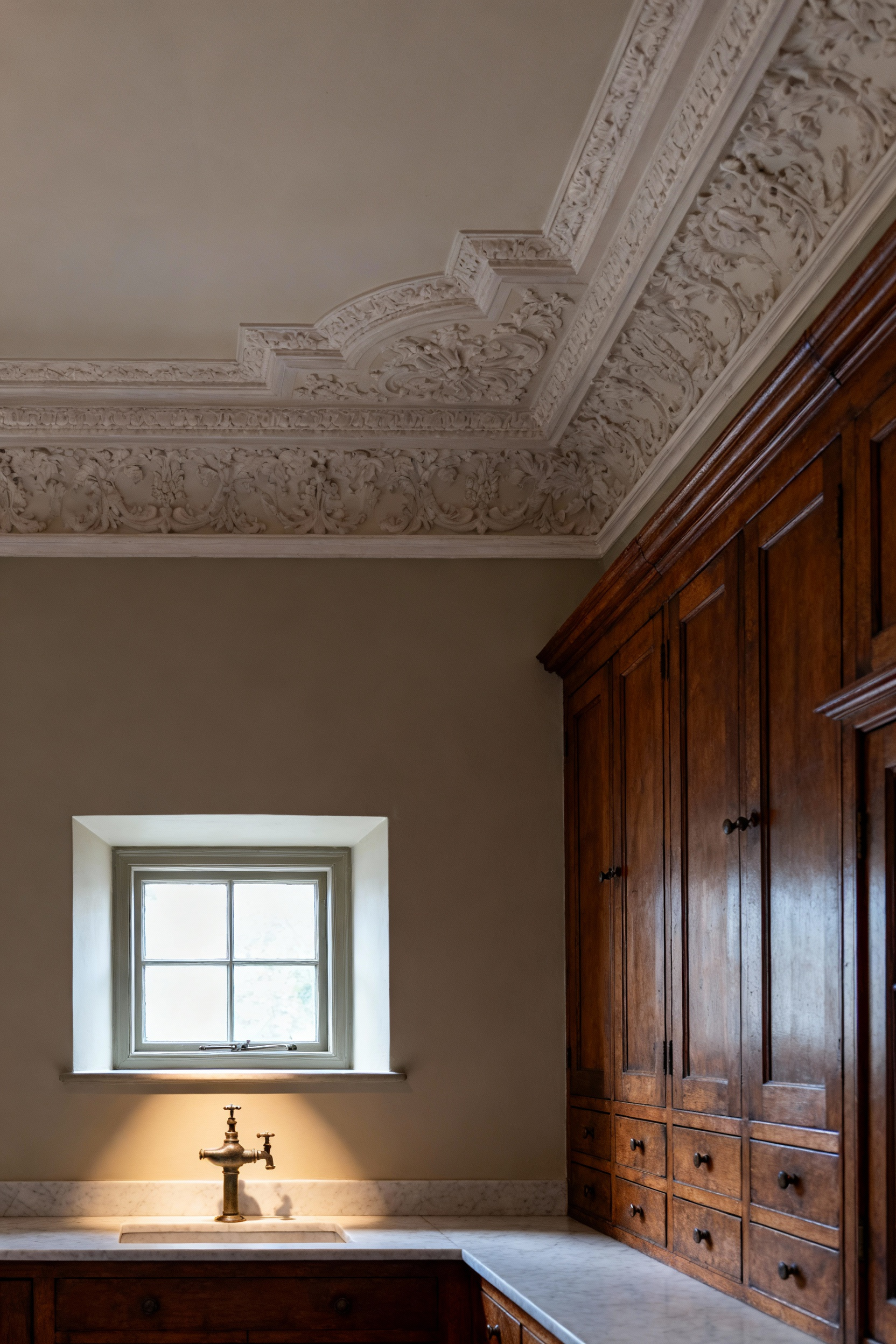
At the end of every project, I provide my clients with a comprehensive “owner’s manual” for their new kitchen. It includes all the paint colors, appliance models, material sources, and specific care instructions for every surface and fixture. This document transforms home maintenance from a reactive chore into a proactive ritual of stewardship. It ensures that the craftsmanship you invested in is preserved and that the kitchen continues to look and function beautifully for decades to come.
19. Craft a Sensory-Rich Environment
Beyond pure function, a great kitchen should just feel good to be in. This comes from creating a sensory-rich environment through the careful layering of light and tactile finishes. This is about engaging more than just the eye. It’s the contrast between the cool, smooth feel of a marble countertop and the warm, grainy texture of a wooden cutting board. It’s the pleasing weight of a solid brass cabinet pull in your hand.

Lighting is crucial here. You need layers: bright, focused task lighting over your prep areas; warm, ambient light for the overall room; and soft, accent lighting to highlight a beautiful piece of pottery or an architectural detail. Everything should be on dimmers. This allows you to completely change the mood of the room, from a bright, energetic workspace to an intimate, cozy spot for a late-night snack. A thoughtfully designed kitchen engages all the senses and enhances your well-being every time you walk into it.
Lifestyle Integration: Sustaining Legacy and Modern Livability (Part 2)
Finally, our last consideration is about looking forward. The work you do today isn’t just for you. It’s for the next family that will call this house home. A truly successful historic kitchen remodel is about future-proofing—creating a space that is so classic, functional, and well-crafted that it will endure for generations.
20. Future-Proof for Generations and Lasting Value
Future-proofing is the ultimate act of stewardship. It’s about making choices that transcend trends and will still feel right in 30 years. This means choosing classic, durable materials that age gracefully—real wood cabinets, natural stone counters, high-quality plumbing fixtures. It means creating a layout that is logical and flexible, capable of adapting to new technologies and changing family structures.
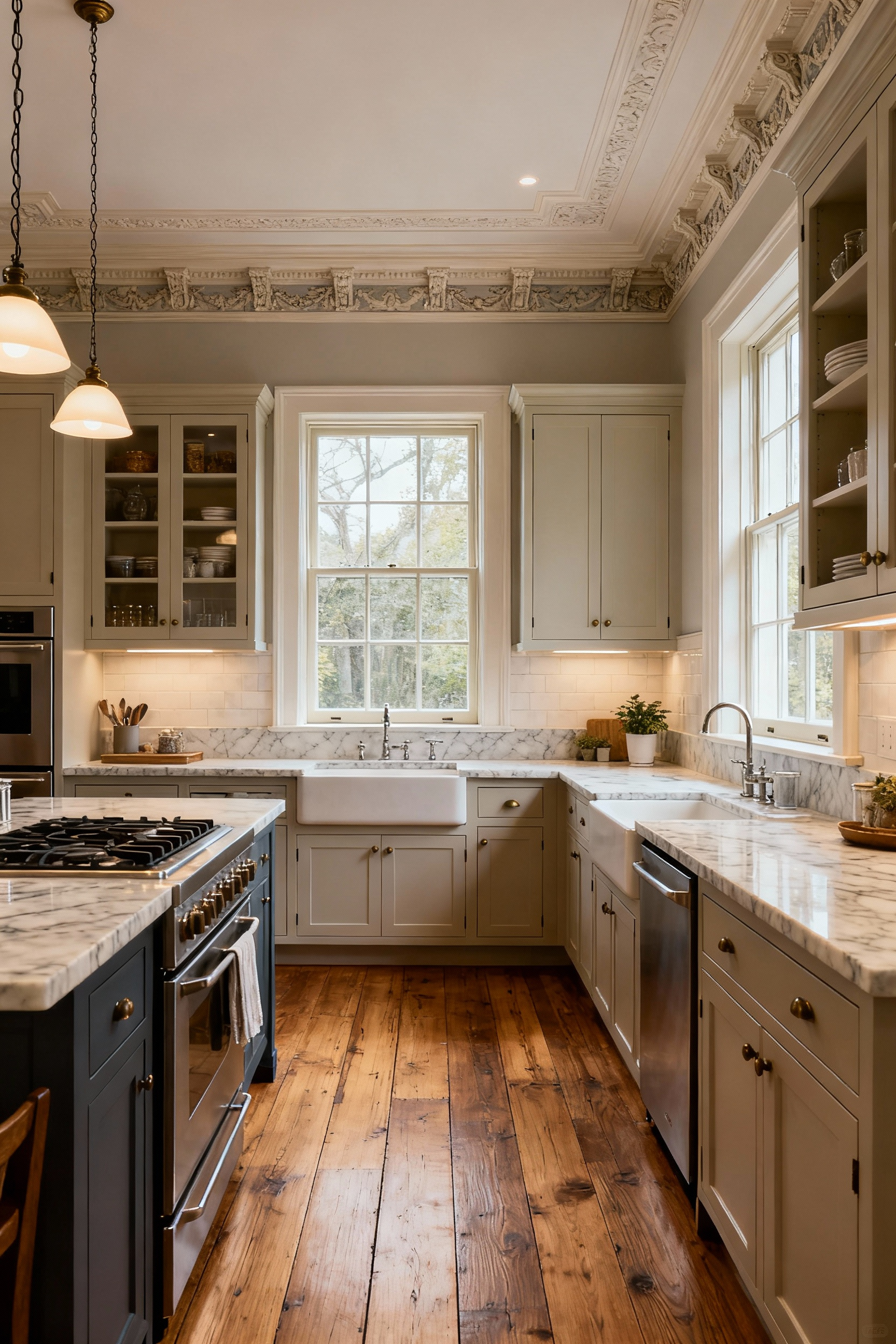
This approach requires resisting the urge to install the “hot” new color or tile pattern of the moment. Instead, invest in quality craftsmanship and timeless design. A kitchen built with these principles is not only a joy to live in but also significantly enhances your home’s long-term property value. Discerning buyers of historic properties aren’t looking for fleeting trends; they’re looking for authenticity and intelligent, lasting renovations. When you get this right, you’re not just remodeling a kitchen. You’re adding another rich chapter to your home’s long story, ensuring its heart continues to beat strongly for generations to come.
Conclusion
We’ve journeyed through these twenty kitchen remodeling ideas not just as a checklist, but as a framework for thinking about the soul of your historic home. It’s a process that demands a unique blend of historical reverence and modern-day pragmatism. From understanding the architectural story held within your walls to selecting materials that feel honest and true to the home’s character, every step is an opportunity to honor the past while thoughtfully providing for the future.
The task may seem daunting, but the reward—a kitchen that feels both perfectly new and as if it has always been there—is one of the most gratifying experiences a homeowner can have. I urge you to approach your project with patience, curiosity, and a deep respect for the craftspeople who came before you. By doing so, you’ll create more than just a beautiful, functional space. You will become a vital part of your home’s living history, crafting a legacy of care and thoughtful design that will endure.
